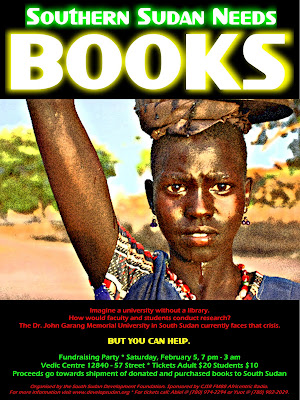A Brave New Sudan... But Without Books?
 Imagine starting a country from scratch, a country devastated by war, poverty, PTSD, and crumbling or nonexistent modern infrastructure.
Imagine starting a country from scratch, a country devastated by war, poverty, PTSD, and crumbling or nonexistent modern infrastructure.Now imagine that your university--the centre for training your country’s leaders--has no library. How do you rate your nation’s chances for stability and prosperity?
Buk Arop is facing that conundrum right now, because his countrymen and –women in South Sudan have voted 99% in favour of separating from the North. And Arap knows as well as anybody that without education, his ancient (and also new) homeland has no future.
Arop, a tall, 29-year-old Sudanese youth worker with movie-star looks, a baritone voice and a gentle demeanour, is the president of the newly-formed South Sudan Development Foundation.
The SSDF’s first major project is to stock—from scratch—the library of the Dr. John Garang Memorial University of Science and Technology , named in honour of the late leader of the Sudanese People’s Liberation Army and Sudan’s First Vice President. That means acquiring second-hand university-level books, and the cash to ship them, half-way around the world. It won’t be cheap—which is why the SSDF is holding a fundraising dinner and dance at E-Town’s Vedic Centre. Says Arop: “To ship a container costs approximately $10,000.”
 While many people characterise southern secession as the result of an “Arab vs. African” conflict, that racial characterisation is misleading. Physically, any Northern Sudanese walking the streets of Harlem—or Edmonton’s Kush—would blend in easily, without anyone offering directions to the Saudi embassy. Instead, Sudan’s north-south divide mirrors that of the Global North and South.
While many people characterise southern secession as the result of an “Arab vs. African” conflict, that racial characterisation is misleading. Physically, any Northern Sudanese walking the streets of Harlem—or Edmonton’s Kush—would blend in easily, without anyone offering directions to the Saudi embassy. Instead, Sudan’s north-south divide mirrors that of the Global North and South.
“If you Google Khartoum, the capital city, you will see skyscrapers; if you see parts of the city, you may think you’re looking at some Western capitol,” says Arop. “But on the flip side, if you Google [Southern capitol] Juba, it’s just typical small-town Africa. It’s not even close to any African capitol,” despite a population of 1.1 million people.
Prior to impending secession, Sudan is currently the largest of Africa’s fifty-four countries, and home to nineteen major ethnicities and 134 languages. To understand the urgency of building Garang U’s library, compare Sudan with Canada. Canada’s 34 million people have 90 universities and 175 colleges serving about 1.7 million students. Sudan’s 40 million people (war has impeded an accurate census) have only 47 universities; Southern Sudan (the size of 1.3 Albertas) has as few as ten universities, serving a population of 11 million (about 3.3 Albertas).
 In 2008, the Government of Southern Sudan established Garang U in the town of Bor, but the campus is off to a hobbling start: so far it has only about 250 students, and doesn’t even have a website. Starving for funds, GU has no student housing, so students live in tents. And a library book budget? Forget about it. It’s a Catch-22 for economic development.
In 2008, the Government of Southern Sudan established Garang U in the town of Bor, but the campus is off to a hobbling start: so far it has only about 250 students, and doesn’t even have a website. Starving for funds, GU has no student housing, so students live in tents. And a library book budget? Forget about it. It’s a Catch-22 for economic development.
“The only employer seems to be the Government of Southern Sudan,” says Arop, noting that local entrepreneurs and businesses are rare. “In Edmonton, if you want to start a business, you can lease a space. But in Juba, you have to start building a building from scratch.” If the Southern Sudanese fail to generate their own economic titans, their national economic sovereignty will inevitably fall into the hands of foreign investors, including those of China.

 The South Sudan book drive is international, originating from a South Sudanese professor in Holland. Arop is impressed by the Edmontonian response, led in part by Political Scientist Chaldeans Mensah at MacEwan University.
The South Sudan book drive is international, originating from a South Sudanese professor in Holland. Arop is impressed by the Edmontonian response, led in part by Political Scientist Chaldeans Mensah at MacEwan University.
“MacEwan University answered the call,” says Arop. “They were involved very quickly [last semester]. I understand that the space that was provided there started to overflow, and the book drive is still going on.”
South Sudan finds its microcosm in Edmonton, which hosts a range of Sudanese ethnicities, including Dinka and Nuer. Arop says local Sudanese may rival the Somalis in numbers—perhaps as many as 15,000—but admits nobody has hard numbers.
While most Sudanese-Canadians have more opportunities here than back home, many face familial and cultural dislocation, post-traumatic stress, under-employment and poverty, high debt from relocation, and savings drained immediately by sending remittances to relatives.
Neverthless, Arop remains optimistic for Sudanese at home and abroad: “Those who will take chances on [the Southern Sudanese people] are definitely going to go down in history as heroes, and will recognised for that.”
Listen to the interview with Buk Arop here.
==========
Books for Sudan Dinner and Dance
$20/$10 Student
Vedic Centre
12840 - 57 street
Saturday, Feb. 5, 7 pm – 3 am
www.developsudan.org
Tickets: 780-974-2294


Comments